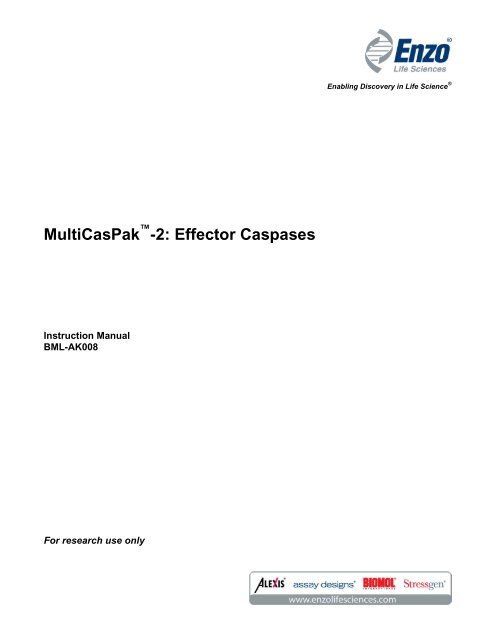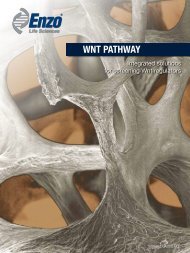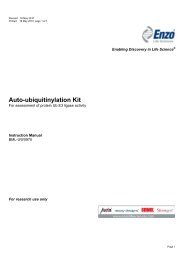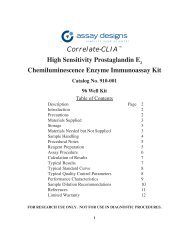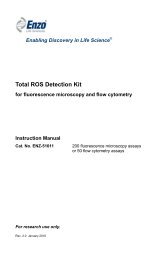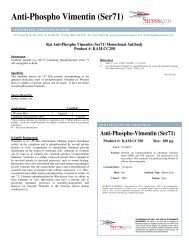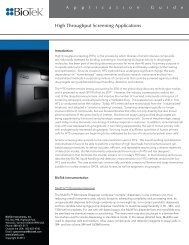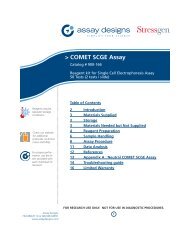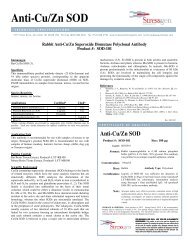AK-008 - Enzo Life Sciences
AK-008 - Enzo Life Sciences
AK-008 - Enzo Life Sciences
- No tags were found...
Create successful ePaper yourself
Turn your PDF publications into a flip-book with our unique Google optimized e-Paper software.
Enabling Discovery in <strong>Life</strong> Science ®MultiCasPak -2: Effector CaspasesInstruction ManualBML-<strong>AK</strong><strong>008</strong>For research use only
DESCRIPTION/BACKGROUND MultiCasPak-2: Effector Caspases<strong>AK</strong>-<strong>008</strong>Three caspases with short, N-terminalprodomains perform “effector” functions duringapoptosis. Caspases –3, -6 and –7 are activateddownstream of initiator caspases such as –8 or –9 and function to cleave particular (non-caspase)cellular target proteins 1,2 . Classic examples ofsuch targeting include the cleavage of poly(ADPribose)polymerase-1(PARP-1) by caspases –3 3,4or –7 5-8 and the cleavage of lamin A by caspase-6 15,16 . The set of proteins targeted for cleavageby caspases during apoptosis may be relativelylimited 2,9 . A comparison, by 2D electrophoresis,of cellular proteins from non-apoptotic andapoptotic BL60 cells (a Burkitt lymphoma line)detected about eighty altered protein spots 9 . Theidentities of about seventy caspase cleavagetargets are currently known 2 . Caspase cleavage,usually at a single site, can produce variouseffects, direct or indirect, depending on the target.For example, the endonuclease CAD is activatedwhen its inhibitor ICAD is cleaved 10-13 andcleavage of PKCδ releases a catalytically activefragment 16,17 . On the other hand, cleavage ofPARP eliminates its normal activity in DNArepair 3 . Overall, these cleavages result in thefunctional and morphological changes associatedwith the apoptotic cell. These include a turning offof repair mechanisms, a halt in cell-cycleprogression and disassembly of cellular structures(e.g. cytoskeletal breakdown, DNAfragmentation) 1,2 .The distinction between initiator and effectorcaspases can be somewhat fuzzy. Caspase-8 istermed an initiator, since it is activated via bindingto death-receptor complexes 18,19 and then cleavesand activates procaspase-3 20 . But caspase-8also cleaves BID, a Bcl-2/Bax family member,thereby increasing its proapoptotic activity 21-23 .Conversely, also in the context of cross-talkbetween the Apaf/caspase-9 pathway andpathways normally initiated by cell-surface deathreceptors,caspase-3 and caspase-6 can act asthe activators of the long prodomain, nominallyinitiator caspases, caspase–2, -8 and –10 24 .Despite these complexities, caspases –3, -6 and–7 do appear to merit the “effector” designation.As would be expected for enzymes that lie at thebottom of an amplification cascade, caspase-3and caspase-6 isotypes are the most abundantactive caspase species in a variety of apoptoticcells25 . Further, more than two-thirds of theidentified cleavage sites in non-caspase cellularproteins conform to the caspase-3/caspase-7preference for the sequence DXXD 2,26 .<strong>AK</strong>-<strong>008</strong> page 2REFERENCES1. N.A. Thornberry and Y. Lazebnik Science 1998 28113122. D.W. Nicholson Cell Death Differ. 1999 6 10283. S.H. Kaufmann et al. Cancer Res. 1993 53 39764. Y.A. Lazebnik et al. Nature 1994 371 3465. N. Margolin et al. J. Biol. Chem. 1997 272 72236. R.V. Talanian et al. J. Biol. Chem.1997 272 96777. M. Woo et al. Genes Dev. 1998 12 8068. M. Germain et al. J. Biol. Chem. 1999 274 283799. E. Brockstedt et al. J. Biol. Chem. 1998 273 2805710. X. Liu et al. Cell 1997 89 17511. D. Tang and V.J. Kidd J. Biol. Chem. 1998 2732854912. M. Enari et al. Nature 1998 391 4313. H. Sakahira et al. Nature 1998 391 9614. A. Takahashi et al. Proc. Natl. Acad. Sci. USA1996 93 839515. K. Orth et al. J. Biol. Chem. 1996 271 1644316. Y. Emoto et al. EMBO J. 1995 14 614817. T. Ghayur et al. J. Exp. Med. 1996 184 239918. M.P. Boldin et al. Cell 1996 85 80319. M. Muzio et al. Cell 1996 85 81720. T. Fernandes-Alnemri et al. Proc. Natl. Acad. Sci.USA 1996 93 746421. X. Luo et al. Cell 1998 94 48122. H. Li et al. Cell 1998 94 49123. A. Gross et al. J. Biol. Chem. 1999 274 115624. E.A. Slee et al. J. Cell Biol. 1999 144 28125. L. Faleiro et al. EMBO J. 1997 16 227126. N.A. Thornberry et al. J. Biol. Chem. 1997 27217907COMPONENTS OF <strong>AK</strong>-<strong>008</strong>CASPASE-3 ENZYME, SE169-9091 (HUMAN, RECOMBINANT)
FORM: 100 U/µl in 50 mM HEPES, pH 7.4, 100 mM NaCl, 0.5%CHAPS, 10 mM DTT, 1 mM EDTA, 10% glycerol. OneU=1 pmol/min@30°C, 200 µM DEVD-pNA.Purity >90% by SDS-PAGE.STORAGE: -70°C; AVOID FREEZE/THAW CYCLES!QUANTITY: 2000 UPRESENTATION: Screw-cap microfuge tube.CASPASE-6 ENZYME, SE170-9090 (HUMAN, RECOMBINANT)FORM: 100 U/µl in 50 mM HEPES, pH 7.4, 100 mM NaCl, 0.5%CHAPS, 10 mM DTT, 1 mM EDTA, 10% glycerol. OneU=1 pmol/min@30°C, 200 µM VEID-pNA. Purity>80% by SDS-PAGE.STORAGE: -70°C; AVOID FREEZE/THAW CYCLES!QUANTITY: 2000 UPRESENTATION: Screw-cap microfuge tube.CASPASE-7 ENZYME, SE177-9090 (HUMAN, RECOMBINANT)FORM: 100 U/µl in 50 mM HEPES, pH 7.4, 100 mM NaCl, 0.5%CHAPS, 10 mM DTT, 1 mM EDTA, 10% glycerol. OneU=1 pmol/min@30°C, 200 µM DEVD-pNA. Purity>95% by SDS-PAGE.STORAGE: -70°C; AVOID FREEZE/THAW CYCLES!QUANTITY: 2000 UPRESENTATION: Screw-cap microfuge tube.PROCASPASE-3, SE730-9090 (HUMAN, RECOMBINANT)FORM: 0.1 mg/ml in 50 mM HEPES, pH 7.4, 100 mM NaCl, 0.5%CHAPS, 10 mM DTT, 1 mM EDTA, 10% glycerol.Purity >90% by SDS-PAGE.STORAGE: -70°C; AVOID FREEZE/THAW CYCLES!QUANTITY: 2 µg/20 µlPRESENTATION: Screw-cap microfuge tube.APPLICATION EXAMPLESMultiCasPak-2 includes three active human recombinantcaspases and procaspase-3. Possible applications includestudy of enzyme regulation or kinetics (Fig. 1), comparativestudies of substrate or inhibitor specificities (Fig. 2),cleavage of target proteins (Fig. 3) and studies ofprocaspase-3 activation (Fig.4).10.80.60.40.2010.80.60.40.2010.80.60.40.20Caspase-3DEVD IETD LEHD VEID YVADCaspase-6DEVD IETD LEHD VEID YVADCaspase-7DEVD IETD LEHD VEID YVADFigure 2. Relative Rates of Tetrapeptide-pNA Cleavage by EffectorCaspases –3, -6 & -7. Initial rates of p-nitroaniline (pNA) release weredetermined with the 200 µM of the indicated tetrapeptide-pNAs. Assayconditions were as described on data sheets for SE169, SE-170 and SE-177.Figure 1. Kinetics of VEID-pNA Cleavage by Caspase-6. Assayconditions were as described on the SE-170 data sheet, but with 50 U ofcaspase-6 and the indicated concentrations of Ac-VEID-pNA (Cat. No. P-437). Rates (v) were obtained from the slopes of the initial, linear portionof plots of A 405 vs. time. Curve and kinetic parameters derive from a nonlinear,least squares fit to the Michaelis-Menten equation.<strong>AK</strong>-<strong>008</strong> page 3
116 kDaDISCLAIMERFigure 3. Cleavage of PARP-1 by Effector Caspases. Western blotsof PARP-1 digested with caspases –3, -6 or –7. PARP-1 (from bovinethymus, Cat. No. SE-165) at 50 ng/µl was digested with the indicatedactive recombinant caspase at 1 unit/µl (Cat. Nos. SE-169, SE-170, SE-177) for 10 min., 25°C. Samples (125 ng) were electrophoresed on a 4-20% polyacrylamide gel (NOVEX), transferred to nitrocellulose andprobed with anti-PARP-1 (Cat. No. SA-250).AmOD405/min./µg procasp.-3BmOD405/min./µg procasp.-340003000200010005004003002001000Csp.-3 Csp.-6 Csp.-70+Caspase-80 10 20 30 40time, min.+Caspase-9Control0 5 10 15 20 25 30time, min.Control85 kDaNOTE: THE PROCEDURES AND APPLICATION EXAMPLES,DESCRIBED ABOVE, ARE INTENDED ONLY AS GUIDELINES.THE OPTIMAL CONCENTRATIONS OF SUBSTRATES ANDINHIBITORS, ASSAY VOLUMES, BUFFER COMPOSITION,AND OTHER EXPERIMENTAL CONDITIONS MUST BEDETERMINED BY THE INDIVIDUAL USER. NO WARRANTYOR GUARANTEE OF PARTICULAR RESULTS, THROUGH THEUSE OF THESE PROCEDURES, IS MADE OR IMPLIED.USE OF PRODUCTThis product contains research chemicals. Assuch, they should be used and handled only by orunder the supervision of technically qualifiedindividuals. This product is not intended fordiagnostic or human use.WARRANTY<strong>Enzo</strong> <strong>Life</strong> <strong>Sciences</strong> International, Inc. makes nowarranty of any kind, expressed or implied, whichextends beyond the description of the product inthis brochure, except that the material will meetour specifications at the time of delivery. <strong>Enzo</strong><strong>Life</strong> <strong>Sciences</strong> International, Inc. makes noguarantee of results and assumes no liability forinjuries, damages or penalties resulting fromproduct use, since the conditions of handling anduse are beyond our control.<strong>Enzo</strong> <strong>Life</strong> <strong>Sciences</strong> International, Inc.5120 Butler PikePlymouth Meeting, PA 19462Phone: 800-942-0430(610) 941-0430Fax: (610) 941-9252email: info-usa@enzolifesciences.comURL: www.enzolifescieces.com© 2009Figure 4. Procaspase-3 Activation by Caspase-8 (SE-172) andCaspase-9 (SE-173). Procaspase-3 (0.2 mg/ml) was incubated at 37°Cwith 1.5 units/µl Caspase-8 (A; Cat. No. SE-172), 1.5 units/µl Caspase-9(B; Cat. No. SE-173) or alone (A and B, Control). Aliquots of theseactivation reactions were withdrawn and caspase-3 activity determinedas the initial rate of change in OD 405nm due to cleavage of Ac-DEVD-pNA(200 µM, P-412) at 37°C. Direct contributions of Caspase-8 andCaspase-9 to DEVD-pNA cleavage are negligible in this assay,amounting to only 0.2 mOD 405 /min/µg procaspase-3 and 0.0mOD 405 /min/µg procaspase-3 respectively.<strong>AK</strong>-<strong>008</strong> page 4
www.enzolifesciences.comEnabling Discovery in <strong>Life</strong> Science ®North/South America Germany UK & IrelandENZO LIFE SCIENCES INTERNATIONAL, INC. ENZO LIFE SCIENCES GmbH ENZO LIFE SCIENCES (UK) LTD.5120 Butler Pike Marie-Curie-Strasse 8 Palatine HousePlymouth Meeting, PA 19462-1202 / USA DE-79539 Lorrach / Germany Matford CourtTel. 1-800-942-0430/(610)941-0430 Tel. +49/0 7621 5500 526 Exeter EX2 8NL / UKFax (610) 941-9252 Toll Free 0800 664 9518 Tel. 0845 601 1488 (UK customers)info-usa@enzolifesciences.com Fax +49/0 7621 5500 527 Tel. +44/0 1392 825900 (oversees)info-de@enzolifesciences.com Fax +44/0 1392 825910info-uk@enzolifesciences.comSwitzerland & Rest of Europe Benelux FranceENZO LIFE SCIENCES AG ENZO LIFE SCIENCES BVBA ENZO LIFE SCIENCESIndustriestrasse 17, Postfach Melkerijweg 3 c/o Covalab s.a.s.CH-4415 Lausen / Switzerland BE-2240 Zandhoven / Belgium 13, Avenue Albert EinsteinTel. +41/0 61 926 89 89 Tel. +32/0 3 466 04 20 FR-69100 Villeurbanne / FranceFax +41/0 61 926 89 79 Fax +32/0 3 466 04 29 Tel. +33 472 440 655Inf-ch@enzolifesciences.com info-be@enzolifesciences.com Fax +33 437 484 239Info-fr@enzolifesciences.com<strong>AK</strong>-<strong>008</strong> page 5


